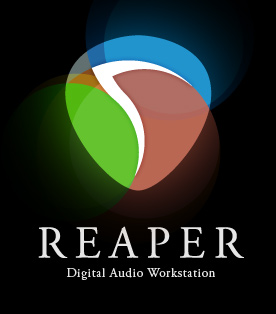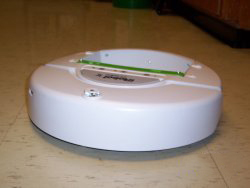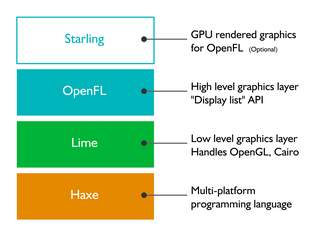
In computing, a plug-in is a software component that adds a specific feature to an existing computer program. When a program supports plug-ins, it enables customization.

Doom II, also known as Doom II: Hell on Earth, is a first-person shooter game in the Doom franchise developed by id Software. It was released for MS-DOS in 1994 and Mac OS in 1995. Unlike the original Doom, which was initially only available through shareware and mail order, Doom II was sold in stores.

Roomba is a term that refers to a series of autonomous robotic vacuum cleaners made by the company iRobot, and was first introduced in September 2002. Roombas have a set of sensors which help them navigate the floor area of a home. These sensors can detect the presence of obstacles and steep drops.

Adobe After Effects is a digital visual effects, motion graphics, and compositing application developed by Adobe Inc.; it is used for animation and in the post-production process of film making, video games and television production. Among other things, After Effects can be used for keying, tracking, compositing, and animation. It also functions as a very basic non-linear editor, audio editor, and media transcoder. In 2019, the program won an Academy Award for scientific and technical achievement.

IntelliJ IDEA is an integrated development environment (IDE) written in Java for developing computer software written in Java, Kotlin, Groovy, and other JVM-based languages. It is developed by JetBrains and is available as an Apache 2 Licensed community edition, and in a proprietary commercial edition. Both can be used for commercial development.

iRobot Corporation is an American technology company that designs and builds consumer robots. It was founded in 1990 by three members of MIT's Artificial Intelligence Lab, who designed robots for space exploration and military defense. The company's products include a range of autonomous home vacuum cleaners (Roomba), floor moppers, and other autonomous cleaning devices.

TiddlyWiki is a personal wiki and a non-linear notebook for organising and sharing complex information. It is an open-source single page application wiki in the form of a single HTML file that includes CSS, JavaScript, embedded files such as images, and the text content. It is designed to be easy to customize and re-shape depending on application. It facilitates re-use of content by dividing it into small pieces called Tiddlers.

MediaMonkey is a digital media player and media library application developed by Ventis Media Inc., for organizing and playing audio on Microsoft Windows and Android operating systems. MediaMonkey for Windows includes various management tools, and is extensible using plugins, while MediaMonkey for Android is an adjunct for sharing the library with Android devices. MediaMonkey is commonly displayed/marketed as a solution for managing large libraries of music.

REAPER is a digital audio workstation and MIDI sequencer application created by Cockos. The current version is available for Microsoft Windows, macOS, and Linux. REAPER acts as a host to most industry-standard plug-in formats and can import all commonly used media formats, including video. REAPER and its included plug-ins are available in 32-bit and 64-bit format.
Omnipeek is a packet analyzer software tool from Savvius, a LiveAction company, for network troubleshooting and protocol analysis. It supports an application programming interface (API) for plugins.

iRobot Create is a hobbyist robot manufactured by iRobot that was introduced in 2007 and based on their Roomba vacuum cleaning platform. The iRobot Create is explicitly designed for robotics development and improves the experience beyond simply hacking the Roomba. The Create replaces its Roomba predecessor's vacuum cleaner hardware with a cargo bay that also houses a DB-9 port providing serial communication, digital input & output, analog input & output, and an electric power supply. The Create also has a 7-pin Mini-DIN serial port through which sensor data can be read and motor commands can be issued using the iRobot Roomba Open Interface (ROI) protocol.

Kinect is a discontinued line of motion sensing input devices produced by Microsoft and first released in 2010. The devices generally contain RGB cameras, and infrared projectors and detectors that map depth through either structured light or time of flight calculations, which can in turn be used to perform real-time gesture recognition and body skeletal detection, among other capabilities. They also contain microphones that can be used for speech recognition and voice control.

Darktable is a free and open-source photography application and raw developer. Rather than being a raster graphics editor like Adobe Photoshop or GIMP, it comprises a subset of image editing operations specifically aimed at non-destructive raw image post-production. It is primarily focused on improving a photographer's workflow by facilitating the handling of large numbers of images. It is freely available in versions tailored for most major Linux distributions, macOS, Solaris and Windows and is released under the GPL-3.0-or-later.

Construct is an HTML5-based 2D video game engine developed by Scirra Ltd. It is aimed primarily at non-programmers, allowing quick creation of games through visual programming. First released as a GPL-licensed DirectX 9 game engine for Microsoft Windows with Python programming on October 27, 2007, it later became proprietary software with Construct 2, as well as switching its API technology from DirectX to NW.js and HTML5, as well as removing Python and adding JavaScript support and its plugin SDK in 2012, and eventually switched to a subscription-based model as a web app.

OpenFL is a free and open-source software framework and platform for the creation of multi-platform applications and video games. OpenFL applications can be written in Haxe, JavaScript, or TypeScript, and may be published as standalone applications for several targets including iOS, Android, HTML5, Windows, macOS, Linux, WebAssembly, Flash, AIR, PlayStation 4, PlayStation 3, PlayStation Vita, Xbox One, Wii U, TiVo, Raspberry Pi, and Node.js.

Art of Illusion is a free software, and open source software package for making 3D graphics.

Babylon.js is a JavaScript library and 3D engine for displaying real time 3D graphics in a web browser via HTML5. The source code is available on GitHub and distributed under the Apache License 2.0.

ESLint is a static code analysis tool for identifying problematic patterns found in JavaScript code. It was created by Nicholas C. Zakas in 2013. Rules in ESLint are configurable, and customized rules can be defined and loaded. ESLint covers both code quality and coding style issues. ESLint supports current standards of ECMAScript, and experimental syntax from drafts for future standards. Code using JSX or TypeScript can also be processed when a plugin or transpiler is used.
Osmocom is an open-source software project that implements multiple mobile communication standards, including GSM, DECT, TETRA and others.













